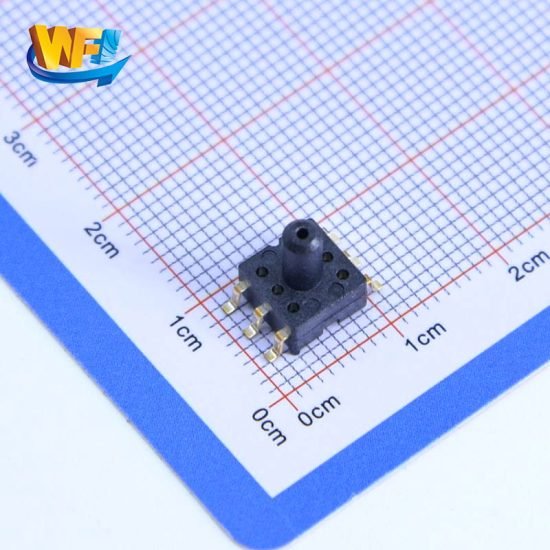Moderne vakuumpumper er ikke længere begrænset til blot at generere sug – de udvikler sig mod smart, præcis kontrol. Ved at integrere tryksensorer med høj nøjagtighed kan vakuumpumpesystemer overvåge undertryk i realtid og dynamisk justere output, hvilket sikrer stabil drift og nøjagtig måling, samtidig med at udstyrsrisici minimeres. Denne artikel dykker ned i, hvordan vakuumpumpetryksensorer, såsom dem i WF100E serien, udnytte avanceret teknologi til at opnå højnøjagtig negativ trykmåling, hvilket revolutionerer applikationer i industrielle, medicinske og IoT-miljøer.
Katalog
Sådan fungerer tryksensoren
Kernen i en vakuumpumpe er dens evne til at generere og opretholde et stabilt undertryk, en opgave der kræver præcis trykmåling. WF100E-seriens sensorer anvender banebrydende MEMS-teknologi kombineret med CMOS blandet signalbehandling for at sikre, at hver måling lever op til høje nøjagtighedsstandarder. Nøgleaspekter af deres drift omfatter:
Real-time trykovervågning
Sensoren konverterer fysisk tryk til et elektrisk spændingssignal med et standardudgangsområde på 0,2–4,7V. Ved hjælp af formlen

den beregner undertrykket nøjagtigt.
Temperaturkompensation og langtidsstabilitet
Sensoren fungerer over et bredt temperaturområde fra -40°C til 125°C og bevarer høj linearitet (≤0,5 % FS-fejl) og lav nuldrift (±0,03 FS/°C), hvilket sikrer pålidelig ydeevne under varierende miljøforhold.
Signalbehandling og datatransmission
En integreret signalbehandling ASIC forstærker og korrigerer råsignalet og transmitterer data via standardgrænseflader (såsom I2C eller SPI) til styresystemet til dynamisk undertryksregulering.
Vigtigheden af intelligent negativt trykkontrol
I mange applikationer påvirker måling af undertryk ikke kun effektiviteten af et system, men også dets sikkerhed og brugerkomfort:
Præcisionskontrol
Med datafeedback i realtid kan vakuumpumpen automatisk justere sugningen for at opretholde undertrykket inden for et optimalt område og undgå problemer forårsaget af for stort eller utilstrækkeligt sug.
Forbedret systemeffektivitet
Dynamisk sugejustering fører til mere responsive operationer, kortere arbejdscyklusser, reduceret energiforbrug og længere levetid for udstyret.
Smart Data Management
Når de kombineres med IoT-teknologi, kan sensorer transmittere realtidsdata til cloud-platforme, hvilket gør det muligt for brugere eller teknikere at analysere og optimere driftsparametre for smartere fremstilling og fjernovervågning.
Rollen af tryksensorer i vakuumpumpesystemer
Tryksensorer spiller en afgørende rolle i vakuumpumpesystemer med vigtige fordele, herunder:
Realtidsovervågning af negative trykændringer
Nøjagtig måling af alle trykudsving giver et pålideligt datagrundlag for systemet.
Automatisk sugejustering
Baseret på realtidsdata kan systemet hurtigt modulere sugningen for at holde undertrykket inden for et forudindstillet område, hvilket forbedrer den samlede stabilitet.
Datalogning og fjernstyring
Med visualiseringsplatforme kan brugere spore historiske data, analysere systemets ydeevne og proaktivt adressere potentielle problemer.
Optimeret teknik og vedligeholdelse
Høj integration reducerer kredsløbskompleksitet, forenkler systemdesign og strømliner vedligeholdelsesindsatsen.
Detaljerede driftsparametre for vakuumsensorer (supplerende)
Med udgangspunkt i den overordnede systemrolle skal vakuumsensorer også opfylde en række strenge tekniske krav for at sikre, at vakuumpumper fungerer pålideligt og effektivt under forskellige forhold. Specifikt er sensorerne designet med følgende funktioner:
Trykmåleområde:
Typisk designet til at arbejde inden for en række af -100kPa til 0kPa, hvilket sikrer dækning til de fleste vakuumpumpeapplikationer.
Nøjagtighed:
Sensoren opretholder en fuldskala fejl indeni ±1 % span, kombineret med lav nuldrift (±0,03 FS/℃) for at levere langsigtede målinger med høj nøjagtighed.
Opløsning:
Ved at udnytte standardudgangsområdet på 0,2–4,7V og konverteringsformlen svarer hver trinvise spændingsændring til subtile trykvariationer, hvilket gør det muligt for sensoren effektivt at detektere selv mindre udsving (0.001kPa opløsning).
Svarrate:
Ved at bruge avanceret MEMS-teknologi og integreret signalbehandling tilbyder sensoren hurtig 1 ms reaktionsevner til at fange trykændringer i realtid, opfylde dynamiske belastningskrav og muliggøre hurtige sugejusteringer.
Driftstemperaturkompensation:
Med et robust driftsområde fra -40°C til 125°C minimerer sensorens indbyggede temperaturkompensationsmekanisme virkningen af temperaturudsving på målenøjagtigheden, hvilket sikrer høj linearitet og præcision i forskellige miljøer.
Konklusion
Integrationen af tryksensorer i vakuumpumpesystemer driver et skift fra konventionel sugestyring til smart præcisionsstyring. Repræsenteret af WF100E-serien, højpræcisionssensorer udmærker sig i realtidsmåling, automatisk justering og temperaturkompensation og tilbyder sikre, effektive og intelligente løsninger på tværs af forskellige industrier. Efterhånden som teknologien udvikler sig, kan vi forvente, at disse smarte systemer vil spille en endnu større rolle i industriel automation, sundhedspleje og IoT-applikationer – der sætter nye benchmarks for innovation og pålidelighed.
Ovenstående introduktion ridser kun overfladen af anvendelserne af tryksensorteknologi. Vi vil fortsætte med at udforske de forskellige typer sensorelementer, der bruges i forskellige produkter, hvordan de virker, og deres fordele og ulemper. Hvis du gerne vil have flere detaljer om, hvad der diskuteres her, kan du tjekke det relaterede indhold senere i denne vejledning. Hvis du er presset på tid, kan du også klikke her for at downloade detaljerne i denne guide Lufttrykssensor Produkt PDF -data.
For mere information om andre sensorteknologier, venligst Besøg vores Sensors -side.

